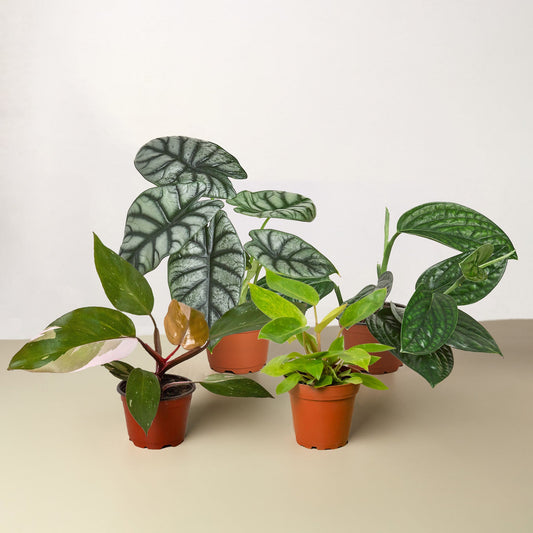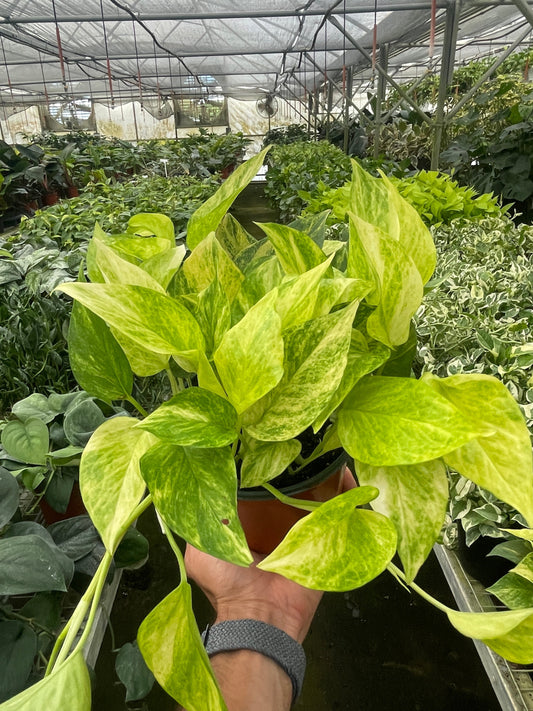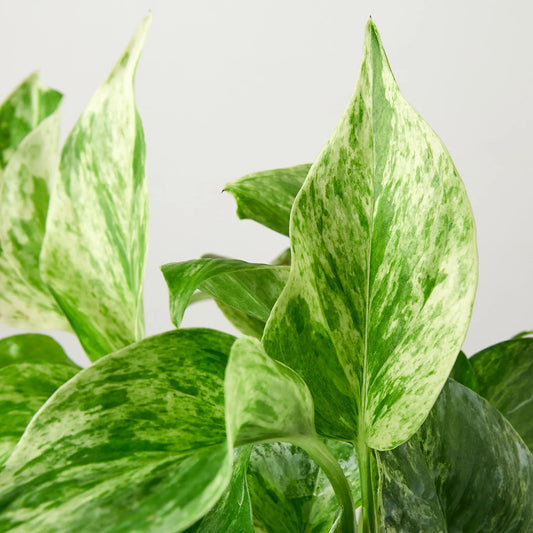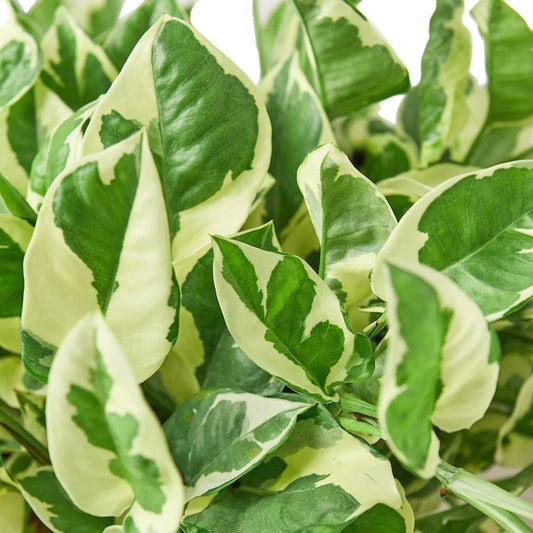How to Repot a Monstera Deliciosa in 5 Easy Steps
Cafe Planta Team
Repotting a Monstera Deliciosa can seem like a big job, but it's an essential part of keeping your plant happy and healthy. Whether you're moving it to a bigger pot or refreshing the soil, knowing how to do it right can make all the difference. This task might sound a bit messy at first, but it's a wonderful way to connect with your plant and ensure it continues to grow beautifully.
In this article, we’ll walk through five straightforward steps to repot your Monstera Deliciosa. From gathering the right tools to choosing the perfect potting mix, we'll cover everything you need to know. By the end, you'll feel confident and ready to give your plant the fresh start it deserves.
Step 1: Gather Your Supplies
The first step in repotting your Monstera Deliciosa is to gather all the necessary supplies. Having everything you need within arm's reach makes the process smooth and stress-free. Here's what you'll need:
- A new pot: Choose a pot that is 2-4 inches larger in diameter than the current one. This will give your Monstera enough room to grow without overwhelming it. Make sure it has drainage holes to prevent waterlogging.
- Potting mix: A well-draining potting mix is key. You can use a blend made specifically for houseplants or create your own mix using peat moss, perlite, and bark.
- Gardening gloves: These are optional but helpful if you want to keep your hands clean and protected from any sharp edges or spines.
- Watering can: You'll need this to water the plant after repotting, ensuring the new soil settles properly around the roots.
- Pruning shears: These are useful if you need to trim any dead or damaged roots.
- A tarp or newspaper: Lay this down to catch any soil spills and make cleanup easier.
Once you have everything ready, you’ll find that the actual repotting process becomes much more straightforward. Preparing in advance takes a lot of the stress out of the situation, letting you focus on the main event: giving your Monstera a new home!
Step 2: Remove the Monstera from Its Current Pot
Now that you have your tools ready, it's time to take your Monstera Deliciosa out of its old pot. This step requires some care to ensure you don't damage the plant or its roots.
Start by gently watering the soil. This helps loosen it, making it easier to remove the plant without causing harm. Once the soil is moist, tip the pot slightly on its side and carefully slide the plant out. If it's stuck, gently tap the sides of the pot to loosen the soil further. Avoid pulling on the plant directly, as this can damage the roots.
If your Monstera is especially large or tangled, you might need a friend to help you. One person can hold the pot, while the other supports the plant as you ease it out. Be patient during this step, as rushing can lead to broken stems or roots.
Once it's out, take a moment to inspect the roots. Healthy roots are white or light brown and firm to the touch. If you notice any dark, mushy roots, these could be signs of root rot and should be trimmed with your pruning shears. Cutting away dead or diseased roots helps your plant focus on growing new, healthy ones.
Step 3: Prepare the New Pot
With your Monstera safely out of its old pot, it's time to prepare the new one. This involves a bit of setup to ensure the plant can thrive in its new environment.
Start by filling the bottom of the pot with a layer of fresh potting mix. Aim for a depth of about 2-4 inches, depending on the size of the pot. This base layer will allow the roots to spread out and anchor themselves properly.
Next, create a small mound in the center of the pot. This will act as a support for the root ball, helping to position the plant at the right height. When you place the plant in the pot, the top of the root ball should be about an inch below the rim of the pot. This ensures there’s enough space to water the plant without overflow.
Don't forget to check the drainage holes. If they're clogged or too small, you might need to adjust them to ensure excess water can escape. Good drainage is crucial to prevent root rot, a common issue with overwatered Monstera plants.
Preparing the pot properly sets the stage for a successful repotting. It's like laying the foundation for a house—you want it to be solid and supportive, giving your Monstera the best possible start in its new home.
Step 4: Position and Plant the Monstera
Now comes the exciting part: placing your Monstera Deliciosa into its new pot. This step is all about positioning the plant correctly so that it can grow healthily and beautifully.
Gently lower the Monstera into the pot, resting the root ball on the mound of soil you created earlier. Take a moment to adjust the plant so it's centered and standing upright. You want the leaves to have room to spread out without being cramped.
Once the plant is in position, start adding potting mix around the root ball. Use your hands to press the soil gently but firmly, ensuring there are no large air pockets. Air pockets can cause the plant to tilt or lead to uneven water distribution, so it's important to pack the soil evenly.
As you fill the pot, keep checking the height of the plant. The top of the root ball should remain about an inch below the rim, allowing for proper watering and soil settling. If needed, adjust the amount of soil to maintain this level.
After the pot is filled, give the plant a gentle shake to help the soil settle. This also helps to eliminate any remaining air pockets. If you notice any areas that need more soil, go ahead and add a little extra.
This step might feel a bit like playing in the dirt, but it's crucial for the health of your Monstera. A well-positioned plant with evenly packed soil will have a much easier time adjusting to its new pot, setting the stage for vibrant growth.
Step 5: Water and Care for Your Newly Potted Monstera
With your Monstera now happily settled in its new pot, it's time to give it a drink and some love. Watering is an important step that helps the plant acclimate to its new environment.
Start by watering the plant thoroughly, ensuring the soil is evenly moist but not waterlogged. It's a good idea to let the water run through the drainage holes to confirm they’re working properly. This first watering helps settle the soil around the roots and gives the plant a good start.
After watering, place your Monstera in a spot with bright, indirect sunlight. While it adjusts to the new pot, it might be a bit sensitive, so avoid direct sun that could scorch the leaves. A spot near a window with filtered light is ideal.
For the first few weeks, keep an eye on the soil moisture. The plant might need a bit more water than usual as it settles in. However, be cautious not to overwater—Monstera prefer slightly dry periods between waterings.
It's normal for the plant to show some stress after repotting, such as drooping leaves or slight yellowing. Give it time to adjust, and avoid fertilizing until you see new growth, which indicates that the plant is comfortable in its new home.
Repotting is a nurturing process that can breathe new life into your Monstera. By following these steps and giving your plant a little extra care, you'll set it on the path to lush growth and vibrant health.
When to Consider Repotting Again
Now that your Monstera is settled in its new home, you might wonder when you'll need to repeat the process. While there's no one-size-fits-all answer, there are some signs to look out for that indicate it might be time for another repot.
Generally, Monsteras need repotting every 1-2 years. If you're unsure, here are a few clues to watch for:
- Root-bound plant: If you notice roots growing out of the drainage holes or circling the pot's interior, your Monstera might be root-bound and need more space.
- Slow growth: If the plant seems to have stopped growing despite proper care, it might be due for a repot to refresh the soil and give the roots more room.
- Wilting or yellowing leaves: While these can be signs of various issues, if you've ruled out other problems, it might be time to check the roots and consider repotting.
Keeping an eye on your Monstera's growth and behavior will help you decide when it's time for another move. Repotting at the right moment ensures the plant continues to thrive and grow beautifully.
Choosing the Right Potting Mix
Selecting the right potting mix for your Monstera Deliciosa is crucial to its health and growth. These plants thrive in a mix that provides both aeration and moisture retention, mimicking their natural environment.
If you prefer a ready-made option, look for a high-quality houseplant potting mix. These often contain a balanced blend of peat, perlite, and bark, offering the right combination of drainage and nutrient retention.
If you're up for a bit of DIY, consider making your own mix! Here's a simple recipe that's perfect for Monstera:
- Two parts peat moss: Peat helps retain moisture without becoming waterlogged.
- One part perlite: Perlite improves drainage and aeration, preventing the soil from compacting.
- One part bark: Bark adds texture and further improves drainage, imitating the Monstera's natural habitat.
Once you've chosen or mixed your soil, make sure to test its drainage. Water should pass through the soil easily without pooling on top or draining too quickly.
Choosing the right potting mix might seem like a small detail, but it makes a significant difference in how your Monstera grows. A well-draining, nutrient-rich soil ensures your plant has the best possible foundation for healthy growth.
Understanding Monstera’s Growth Patterns
Monstera Deliciosa, often called the Swiss Cheese Plant, is loved for its distinctively split leaves and climbing growth habit. Understanding how this plant grows can help you care for it more effectively after repotting.
Monsteras are natural climbers. In the wild, they use aerial roots to cling to trees and climb towards the light. While your indoor Monstera won't need to climb a tree, providing a moss pole or trellis can support its natural growth pattern, encouraging those beautiful split leaves to develop.
These plants also grow quickly, especially in the right conditions. Bright indirect light, high humidity, and regular watering all contribute to faster growth. If you notice new leaves unfurling, it's a sign that your Monstera is happy and thriving in its environment.
It's fascinating to watch a Monstera grow and change. The leaves start as small, heart-shaped forms and gradually develop splits and holes as they mature. This process, called fenestration, is part of what makes Monsteras so unique and beloved by plant lovers.
By understanding how your Monstera grows, you can better tailor your care to its needs, ensuring it remains a vibrant and stunning addition to your home.
Common Mistakes and How to Avoid Them
Repotting can be a bit tricky, and even seasoned plant parents sometimes encounter hiccups. But don't worry—most mistakes are easy to fix or avoid with a little forethought.
Overwatering: After repotting, it's tempting to water frequently, but this can lead to root rot. Ensure your pot has good drainage and allow the soil to dry out slightly between waterings.
Using the wrong pot size: A pot that's too large can hold excess moisture, risking root rot. Stick to a pot 2-4 inches larger in diameter than the current one.
Not acclimating the plant: After repotting, your Monstera might be a bit stressed. Give it time to adjust by keeping it in a stable environment with consistent light and temperature.
Ignoring root health: Always inspect the roots when repotting. Trim any dead or rotting parts to prevent the spread of disease.
By keeping these common pitfalls in mind, you can help your Monstera transition smoothly to its new home, avoiding any unnecessary stress or setbacks.
Final Thoughts
Repotting a Monstera Deliciosa doesn't have to be daunting. By following these five steps, you can give your plant a fresh start and set it up for continued growth and health. Remember, patience and care are key, and your efforts will pay off with a thriving, beautiful plant.
At Cafe Planta, we're here to support your plant journey. Whether you're looking for new additions to your collection or need expert advice, we've got you covered. Feel free to reach out to us via email or DM us on Instagram. We believe in the power of plants to bring joy and connection, and we're excited to help you create a beautiful, thriving indoor garden.



















